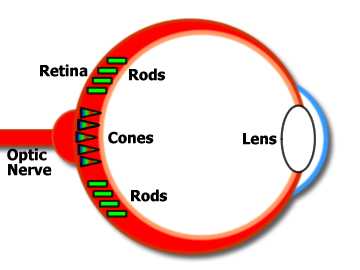Our eyes, the windows to our perception of the world, embark on a remarkable journey every time light beams into them. As the light rays penetrate the curvature of the lens, they initiate a cascade of events that lead to meaningful visual information reaching our brains. Central to this awe-inspiring process are two exceptional sensory cells – rods and cones – facing the light with relentless determination, ready to unravel its secrets.
:max_bytes(150000):strip_icc()/GettyImages-738786957-5fa55208553d48939fac8d73443faa39.jpg)
Image: www.verywellhealth.com
Rods and cones, the photoreceptor cells of our retinas, each possess unique roles in shaping our visual experience. As the light strikes these cells, a complex interplay of molecular processes transforms the energy of the photons into electrical signals, kickstarting the path to vision.
Rods: Masters of Dim Light and Peripheral Vision
Shrouded in the dimmer corners of our visual experience, rods stand as the unsung heroes of night vision and peripheral awareness. Thriving in the shadows where cones falter, rods are equipped with an astonishingly low light threshold, allowing us to navigate the world in moonlit streets and starlit nights.
Scattered throughout the retina’s outer region, rods are closely packed in an array that extends nearly to the point directly opposite the pupil. This strategic placement facilitates expansive peripheral vision, creating a near-panoramic view essential for detecting movement in our surroundings.
Cones: The Chromatic Champions
Under the brilliance of daylight, a vibrant dance of colors unfolds before us – an orchestration led by the exquisite sensitivity of cones. Abundant in the retina’s central region, known as the macula, cones excel at translating the colors we behold.
Three Cone Types: The Key to Color Vision
Wavelengths of light find their perfect partners in the three distinct types of cones: short, medium, and long. Each cone is attuned to a specific range of wavelengths, effectively parsing white light into its chromatic components.
When these cone types act in concert, our eyes perform the extraordinary feat of combining information about red, green, and blue wavelengths, composing the full spectrum of hues our visual world has to offer.

Image: www.markthompsonastronomy.com
Visual Processing: A Unified Endeavor
Rods and cones, though distinct in their functions, converge their electrical signals onto ganglion cells within the retina, initiating the passage of visual information towards the brain. The combined input of these two cell types crafts a unified visual representation, informing our perceptions of spatial relationships, object boundaries, and the intricacies of color.
Preservation and Vulnerability of Rods and Cones
The intricate workings of rods and cones are essential to our visual prowess. Maintaining their health is paramount, as external factors and internal vulnerabilities can impair their function, leading to visual disturbances or even permanent vision impairment.
Excessive exposure to ultraviolet light, a common threat posed by sunlight, can cause damage to the delicate structures of these retinal cells. Retinal diseases, such as age-related macular degeneration, uveitis, and retinitis pigmentosa, can also disrupt rod and cone function, leading to a range of symptoms that require prompt medical attention.
Adaptive Innovations for Optimal Vision
The human visual system is armed with a remarkable arsenal of adaptive mechanisms, ensuring that rods and cones perform optimally in a wide array of lighting conditions. Pupillary reflexes, for example, orchestrate changes in pupil size to regulate the amount of light entering the eye, optimizing brightness perception.
Additionally, our eyes harness the power of accommodation, modulating lens shape to adjust focus for clear vision at different distances. These intricate adaptations exemplify the resilience and sophistication of our visual machinery.
Rods And Cones Face The Light Coming Into The Eye.
A Testament to Visual Wonder
Our ability to perceive the world in all its vibrant glory is a testament to the tireless efforts of rods and cones, facing the light with unwavering determination. Each of these tiny sensory cells plays an indispensable role in composing our visual masterpiece, the window through which we connect to the complexities of our surroundings.

